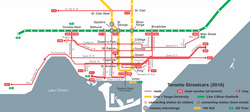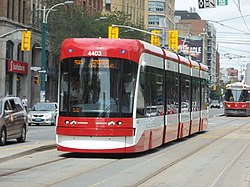Toronto streetcar system
The Toronto streetcar system is a network of eleven streetcar routes in the Canadian city of Toronto, Ontario. It is by far the largest network of its kind in the Americas.[5] It operates as part of the Toronto Transit Commission's public transport network, and shares a common fare system with buses and subway services.
| Toronto streetcar system | |||
|---|---|---|---|
 Toronto streetcar in May 2009. | |||
| Info | |||
| Locale | Toronto, Ontario, Canada | ||
| Transit type | Streetcar | ||
| Number of lines | 11[1] | ||
| Number of stations | 685 stops | ||
| Daily ridership | 292,100 (avg. weekday, Q4 2016)[2] | ||
| Operation | |||
| Began operation | 1861 (electric lines since 1892)[1] | ||
| Operator(s) | Toronto Transit Commission | ||
| Technical | |||
| System length | 83 km (52 mi)[3] | ||
| Track gauge | Lua error in package.lua at line 80: module 'Module:Track gauge/data' not found. | ||
| Minimum radius of curvature | 36 ft 0 in (10,973 mm)[4] | ||
| Electrification | Overhead lines, 600 V DC | ||
| |||
Unlike modern light rail systems that are becoming more commonplace in North America, streetcars runs on city streets and call at frequent bus-type stops, where the passenger waits on the sidewalk for the next streetcar and pays his or her fare on board the vehicle. There are 685 of these stops, eight of which are shared with and connect to the subway system. The system mainly serves the downtown and waterfront areas of the city, and acts as feeder routes to the subway.
The system, which has been one of the longest in continuous operation, was opened in 1861 as a horse tramway.[6][7] The system was bought by the Toronto Railway Company in 1891 and it was electrified in 1892.[7] Vehicles run on 82 km (51 mi) of tracks with a non-standard gauge of Lua error in package.lua at line 80: module 'Module:Track gauge/data' not found. and collect power from overhead lines at 600 V DC using trolley poles mounted on each streetcar.
More than 300,000 people ride the system on an average weekday, and about 100 million on an annual basis, making it among the busiest systems in the world.
Toronto Streetcar System Media
Horse-drawn Toronto Street Railway streetcars, 1890. By 1894, horse-drawn streetcars were replaced by electric streetcars.
Streetcar and trolleybus routes in October 1965
A Parliament line streetcar at Viaduct Loop. Parliament line was one of several streetcar routes discontinued in the 1960s.
Two TTC streetcar models used in the 20th century. The CLRV model to the left entered service in 1979, eventually replacing the PCC model next to it.
A CLRV streetcar on College Street in April 1997.
A CLRV streetcar operating on a reserved track on route 512 St. Clair. Dedicated right-of-way lanes were completed on route 512 in 2010.
A Flexity Outlook streetcar on its first day of service, August 31, 2014, on route 510 Spadina
TTC chair Josh Colle speaking at the launch ceremony for 514 Cherry, in June 2016
An ALRV on the day of its retirement. The vehicles were retired in September 2019.
References
- ↑ 1.0 1.1 "Toronto's Streetcar Network - Past to Present - History". 2013. Archived from the original on 2021-02-11. Retrieved 2013-07-26.
- ↑ "Public Transportation Ridership Report Fourth Quarter 2016" (PDF). American Public Transportation Association (APTA). March 3, 2017. p. 34. Archived from the original (PDF) on 2017-03-20. Retrieved 2017-11-12.
- ↑ "UrbanRail.Net > North America > Canada > Ontario > Toronto Streetcar (Tram)". www.urbanrail.net.
- ↑ The Canadian Light Rail Vehicles - Transit Toronto
- ↑ Page, Graham (30 June 2014). "Toronto: The City that Saved its Streetcar Tracks". Rivard Report. Retrieved 20 February 2016.
- ↑ "A Brief History of Transit in Toronto - Transit Toronto - Content". transit.toronto.on.ca. 2012. Retrieved February 7, 2015.
- ↑ 7.0 7.1 Clarke, Paul (31 August 2014). "Five historical facts about Toronto's streetcar system". The Star. Archived from the original on 18 April 2016. Retrieved 20 February 2016.










